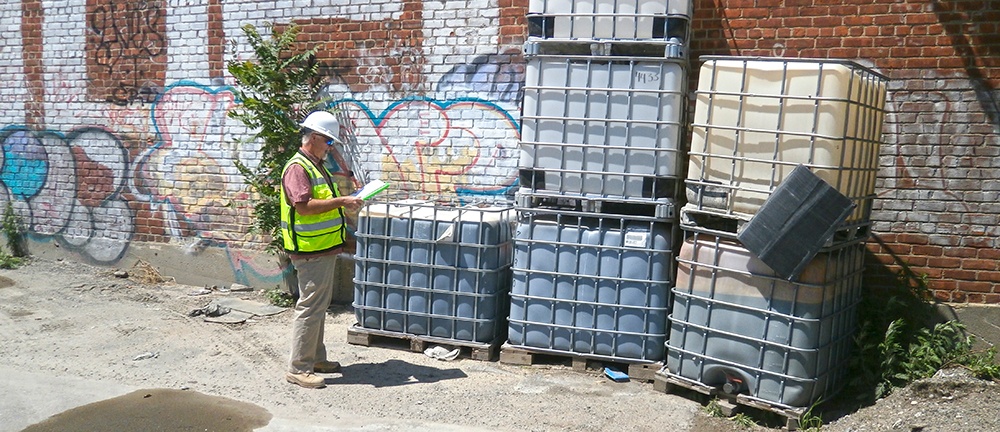We explain the relationship between GPR scans, Phase I ESAs, and USTs.
For many folks who've never dealt with a Phase I ESA before, and even for folks who have, there tends to be some confusion regarding what's necessary, what's required, and what's not. Often times we get asked if some type of investigation for the presence of buried underground storage tanks (USTs) is included as part of a Phase I ESA.
Seems to be a great frequently asked question, since USTs are definitely known to be sources of soil and groundwater contamination, they're pretty common at various types of facilities, and are usually a primarily concern at any type of property being evaluated. But, this is where the confusion comes in, and understandably so. Many people want to know if those tanks are there, how do we find them? Start taking soil samples? How about ground penetrating radar scans? How can we be sure that a Phase I ESA identifies any USTs at a facility?!
Fear not, there's a process and a methodology to figure this out. So, let's dive into this, explain what's going on with USTs, GPR, and Phase I ESAs, and help you figure a few things out.
Phase I Environmental Site Assessments & Ground Penetrating Radar Scans
The short answer is this: a Phase I Environmental Site Assessment does not include any ground penetrating radar scans.
In order to understand why, let's look at Phase I ESAs first.
Quick Info on Phase I Environmental Site Assessments
Here's a super fast explanation of a Phase I ESA.
They're done by most people in order to determine whether or not they're inheriting someone else's environmental problems, and also to protect themselves should something they were unaware of crop up later after they've bought the property. Consider it a type of "liability protection" that you did your homework and are sure you're not buying a piece of contaminated property. After all, you don't want to be held liable for someone else's problems of the past, right?
In order to qualify in the courts for this liability protection, you need to have engaged in a practice of "all appropriate inquiries" into the property and it's history. What's that mean? It's been determined that the way to engage in this all appropriate inquiry practice at a piece of property is to conduct a Phase I Environmental Site Assessment, which has to follow a standard practice (ASTM 1527-13), and be conducted by someone meeting the definition of an "environmental professional".
Here's some associated information to help digest that information:

Phase I ESA "Scope" Items
That methodology for a Phase I ESA outlines a certain "scope" of what's to be evaluated. So when you want protection, you want your Phase I done correctly, it needs to follow this "scope" of services. Anything else is outside the scope, or what we would call "non-scope" items. You can request non-scope items be included as part of your Phase I ESA investigation, which is up to you and your environmental professional. But a standard Phase I ESA does not include non-scope items. Some common "non-scope" items we hear our customers ask for are lead, mold, or asbestos. We explain the concept of "non-scope" items further in our article Phase I ESA, Lead, Mold & Asbestos Inspections.
RECs & Phase I Environmental Site Assessments
The purpose, and only purpose, of a Phase I ESA is to identify what are called "recognized environmental conditions" (RECs) and some variations on RECs. That's it. We dive into this concept in another article entitled What are RECs in a Phase I Environmental Site Assessment?
Long story short, RECs are the "areas of concern" found through a Phase I ESA.
Phase I ESA, Underground Storage Tanks (UST), and Ground Penetrating Radar (GRP) Scans
You're probably thinking "a UST sure sounds like a REC" and you'd be right! But how do we go about finding a UST at a piece of property.
A Phase I Environmental Site Assessment is limited to visual observations and historical research only. That's it. So all the investigation work is done through researching paperwork, discussing the property with current and past owners, and a thorough site investigation by an environmental professional.
If there is a tank, there's either paperwork evidence of installation, registration, or removal, or often physical evidence such as fill ports and piping. If you can't see anything, and there's no history of a tank, then there's probably not a tank, unless site personnel know otherwise.
So how does an environmental professional address the matter of a UST? Let me give you a couple of examples.
- We go out to a site, find out a building formerly used heating oil for heating, and there's no records of tank removals. We visually inspect, and there is a pipe sticking out of the ground which we think might be a fill pipe for a UST. Guess what? We've just identified a REC.
- We go to a site, know there were USTs there which were abandoned in the past, and cannot find any information related to them having been removed. We have certain information on UST presence and no information on their removal - so another REC.
- There's no documentation about any UST on site, but the current site owner/manager/representative swears up and down there's an old tank in the ground that was just covered up with some dirt in the past. Guess what? Another REC!
At that point, the environmental professional has done their job. They've conducted the Phase I ESA, and identified RECs. All that's left is to write the report.
Now it gets a bit tricky.

Shouldn't the Phase I ESA report recommend further investigation of the REC that might be a buried tank? This tank could be leaking and possibly contaminating the soil and groundwater of the property! The answer is no, a Phase I does not include recommendations. Yes, that's right, recommendations are not within the scope of a Phase I ESA. They can be included, should the party who hired the environmental professional request them.
Remember, during a Phase I Environmental Site Assessment there is no testing, sampling, or digging done at all. There are no geophysical surveys, such as the use of a ground penetrating radar (GPR) to see if there are metallic objects such as a buried petroleum UST on the site. No backhoe excavations to see if a tank is present. None of these are in the standard Phase I ESA scope.
So if there's reason to believe that there is a UST, and recommendations were made, then a scan or investigation of the potential presence of USTs could be recommended, and proceed, as part of a Phase II investigation. Use a GPR, dig up the area of the tanks, do whatever is appropriate, but it'd occur as part of Phase II activities, which are wholly separate from a Phase I ESA. To learn more about Phase II's, check out our article What is a Phase II Environmental Site Assessment?
Can we do GPR scans with a Phase I ESA just to be safe?
Well maybe, but in that case, think how many times a GPR or other investigation means would be used needlessly, and raise costs unnecessarily. Better to wait until the Phase I is done, evaluate the RECs identified, ask for recommendations, and proceed with a Phase II investigation of the potential presence of USTs if, and when, indicated as being appropriate.
Imagine you went to the doctor for a checkup and you had a little bruise on your arm. You tell the doctor your arm hurts because you bumped it against the counter the other day and want an x-ray. Do you need one? No, probably not. Can you get one? Of course. But, until that doctor does his evaluation, and gives you his report & recommendation, why would you start asking for things that might not be needed?
So does a Phase I Environmental Site Assessment include any GPR scanning? No. Can you get it included? Yes, but it would be foolish to do it up front. If you push ahead regardless, you're probably going to spend unnecessary time and money, something you probably don't want to waste.














